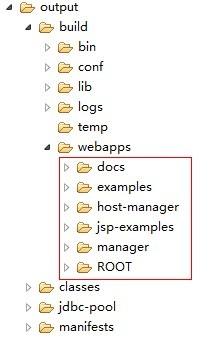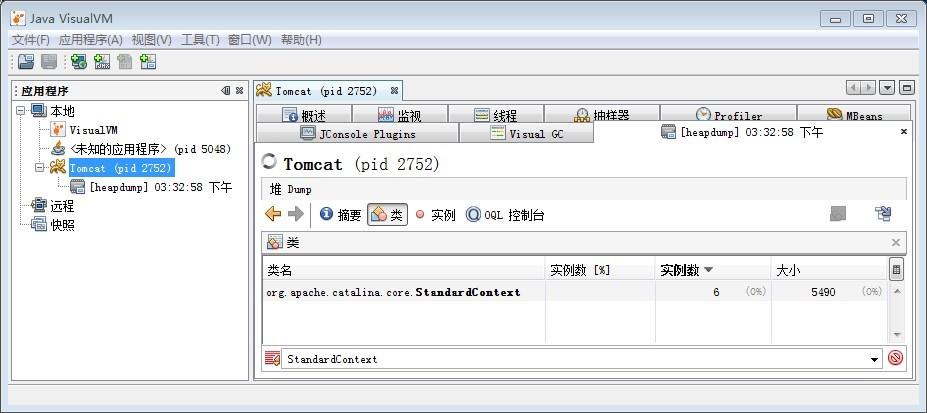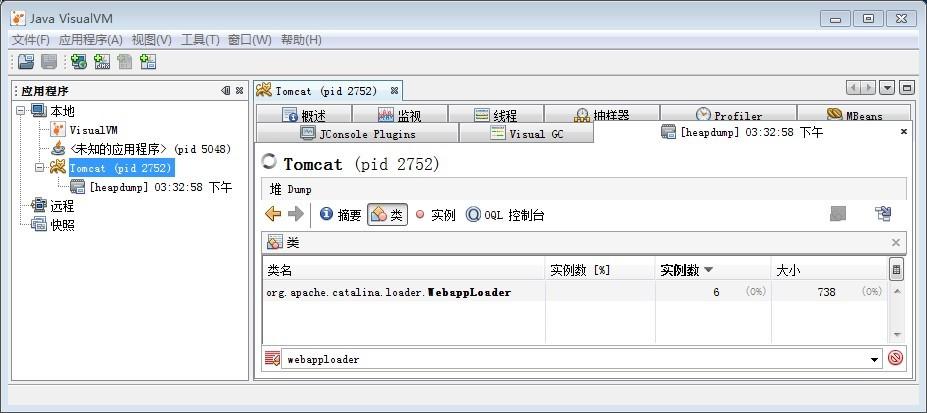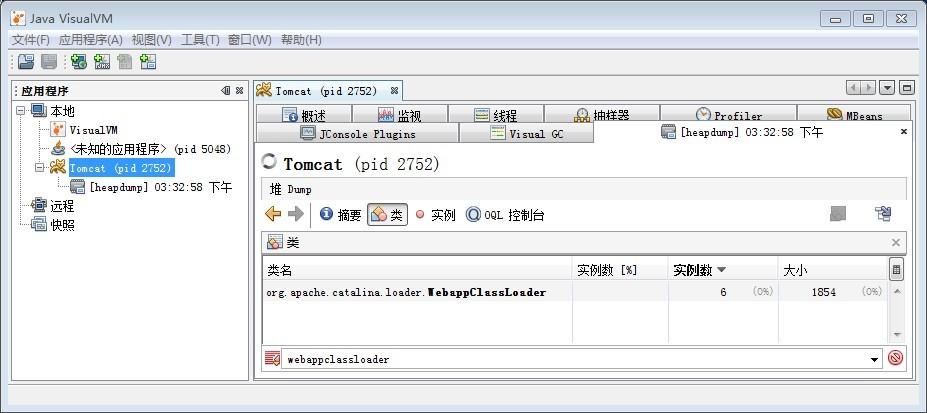在一般的 web 应用开发里通常会使用开发工具(如 Eclipse、IntelJ )集成 tomcat ,这样可以将 web 工程项目直接到 tomcat 中,然后一键启动。经常遇到的一种情况是直接修改一个类的源文件,此时开发工具会直接将编译后的 class 文件到 tomcat 的 web 工程里,但如果 tomcat 没有配置应用的自动加载功能的话,当前 JVM 中运行的 class 还是源文件修改之前编译好的 class 文件。可以重启 tomcat 来加载新的 class 文件,但这样做需要再手工点击一次restart,为了能够在应用中即时看到 java 文件修改之后的执行情况,可以在 tomcat 中将应用配置成自动加载模式,其配置很简单,只要在配置文件的Context节点中加上一个 reloadable 属性为true即可,示例如下:
<Context path="/HelloWorld" docBase="C:/apps/apache-tomcat/DeployedApps/HelloWorld" reloadable="true"/>
如果你的开发工具已经集成了 tomcat 的话应该会有一个操作界面配置来代替手工添加文件信息,如 Eclipse 中是如下界面来配置的:
 此时需要把
此时需要把 Auto reloading enabled前面的复选框钩上。其背后的原理实际也是在 server.xml 文件中加上 Context 节点的描述:
<Context docBase="test" path="/test" reloadable="true"/>
这样 Tomcat 就会监控所配置的 web 应用实际路径下的/WEB-INF/classes和/WEB-INF/lib两个目录下文件的变动,如果发生变更 tomcat 将会自动重启该应用。
熟悉 Tomcat 的人应该都用过这个功能,就不再详述它的配置步骤了。我感兴趣的是这个自动加载功能在 Tomcat 7 中是怎么实现的。
在前面的文章中曾经讲过 Tomcat 7 在启动完成后会有一个后台线程ContainerBackgroundProcessor[StandardEngine[Catalina]],这个线程将会定时(默认为 10 秒)执行 Engine、Host、Context、Wrapper 各容器组件及与它们相关的其它组件的 backgroundProcess 方法,这段代码在所有容器组件的父类org.apache.catalina.core.ContainerBase类的 backgroundProcess`方法中:
public void backgroundProcess() {
if (!getState().isAvailable())
return;
if (cluster != null) {
try {
cluster.backgroundProcess();
} catch (Exception e) {
log.warn(sm.getString("containerBase.backgroundProcess.cluster", cluster), e);
}
}
if (loader != null) {
try {
loader.backgroundProcess();
} catch (Exception e) {
log.warn(sm.getString("containerBase.backgroundProcess.loader", loader), e);
}
}
if (manager != null) {
try {
manager.backgroundProcess();
} catch (Exception e) {
log.warn(sm.getString("containerBase.backgroundProcess.manager", manager), e);
}
}
Realm realm = getRealmInternal();
if (realm != null) {
try {
realm.backgroundProcess();
} catch (Exception e) {
log.warn(sm.getString("containerBase.backgroundProcess.realm", realm), e);
}
}
Valve current = pipeline.getFirst();
while (current != null) {
try {
current.backgroundProcess();
} catch (Exception e) {
log.warn(sm.getString("containerBase.backgroundProcess.valve", current), e);
}
current = current.getNext();
}
fireLifecycleEvent(Lifecycle.PERIODIC_EVENT, null);
}
与自动加载类相关的代码在 loader 的 backgroundProcess 方法的调用时。每一个 StandardContext 会关联一个loader变量,该变量的初始化在org.apache.catalina.core.StandardContext类的 startInternal 方法中的这段代码:
if (getLoader() == null) {
WebappLoader webappLoader = new WebappLoader(getParentClassLoader());
webappLoader.setDelegate(getDelegate());
setLoader(webappLoader);
}
所以上面的 loader.backgroundProcess() 方法的调用将会执行org.apache.catalina.loader.WebappLoader类的 backgroundProcess 方法:
public void backgroundProcess() {
if (reloadable && modified()) {
try {
Thread.currentThread().setContextClassLoader
(WebappLoader.class.getClassLoader());
if (container instanceof StandardContext) {
((StandardContext) container).reload();
}
} finally {
if (container.getLoader() != null) {
Thread.currentThread().setContextClassLoader
(container.getLoader().getClassLoader());
}
}
} else {
closeJARs(false);
}
}
其中reloadable变量的值就是本文开始提到的配置文件的 Context 节点的reloadable属性的值,当它为true并且 modified() 方法返回也是true时就会执行 StandardContext 的 reload 方法:
public synchronized void reload() {
// Validate our current component state
if (!getState().isAvailable())
throw new IllegalStateException
(sm.getString("standardContext.notStarted", getName()));
if(log.isInfoEnabled())
log.info(sm.getString("standardContext.reloadingStarted",
getName()));
// Stop accepting requests temporarily.
setPaused(true);
try {
stop();
} catch (LifecycleException e) {
log.error(
sm.getString("standardContext.stoppingContext", getName()), e);
}
try {
start();
} catch (LifecycleException e) {
log.error(
sm.getString("standardContext.startingContext", getName()), e);
}
setPaused(false);
if(log.isInfoEnabled())
log.info(sm.getString("standardContext.reloadingCompleted",
getName()));
}
reload 方法中将先执行 stop 方法将原有的该 web 应用停掉,再调用 start 方法启动该 Context ,start 方法的分析前文已经说过,stop 方法可以参照 start 方法一样分析,不再赘述。
这里重点要说的是上面提到的监控文件变动的方法 modified ,只有它返回true才会导致应用自动加载。看下该方法的实现:
public boolean modified() {
return classLoader != null ? classLoader.modified() : false ;
}
可以看到这里面实际调用的是 WebappLoader 的实例变量 classLoader 的 modified 方法来判断的,下文就详细分析这个 modified 方法的实现。
先简要说一下 Tomcat 中的加载器。在 Tomcat 7 中每一个 web 应用对应一个 Context 节点,这个节点在 JVM 中就对应一个org.apache.catalina.core.StandardContext对象,而每一个 StandardContext 对象内部都有一个加载器实例变量(即其父类org.apache.catalina.core.ContainerBase的loader实例变量),前面已经看到这个 loader 变量实际上是org.apache.catalina.loader.WebappLoader对象。而每一个 WebappLoader 对象内部关联了一个 classLoader 变量(就这这个类的定义中,可以看到该变量的类型是org.apache.catalina.loader.WebappClassLoader)。
在 Tomcat 7 的源码中给出了 6 个 web 应用:

StandardContext 实例数:
WebappLoader 实例数:
WebappClassLoader 实例数
上面讲过了 WebappLoader 的初始化代码,接下来讲一下 WebappClassLoader 的对象初始化代码。同样还是在 StandardContext 类的 startInternal 方法中,有如下两段代码:
if (getLoader() == null) {
WebappLoader webappLoader = new WebappLoader(getParentClassLoader());
webappLoader.setDelegate(getDelegate());
setLoader(webappLoader);
}
这一段是上面已经说过的 WebappLoader 的初始化。
try {
if (ok) {
// Start our subordinate components, if any
if ((loader != null) && (loader instanceof Lifecycle))
((Lifecycle) loader).start();
这一段与 WebappLoader 的对象相关,执行的就是 WebappLoader 类的 start 方法,因为 WebappLoader 继承自 LifecycleBase 类,所以调用它的 start 方法最终将会执行该类自定义的 startInternal 方法,看下 startInternal 方法中的这段代码:
classLoader = createClassLoader();
classLoader.setResources(container.getResources());
classLoader.setDelegate(this.delegate);
classLoader.setSearchExternalFirst(searchExternalFirst);
if (container instanceof StandardContext) {
classLoader.setAntiJARLocking(
((StandardContext) container).getAntiJARLocking());
classLoader.setClearReferencesStatic(
((StandardContext) container).getClearReferencesStatic());
classLoader.setClearReferencesStopThreads(
((StandardContext) container).getClearReferencesStopThreads());
classLoader.setClearReferencesStopTimerThreads(
((StandardContext) container).getClearReferencesStopTimerThreads());
classLoader.setClearReferencesHttpClientKeepAliveThread(
((StandardContext) container).getClearReferencesHttpClientKeepAliveThread());
}
for (int i = 0; i < repositories.length; i++) {
classLoader.addRepository(repositories[i]);
}
// Configure our repositories
setRepositories();
setClassPath();
setPermissions();
((Lifecycle) classLoader).start();
一开始调用了 createClassLoader 方法:
/**
* Create associated classLoader.
*/
private WebappClassLoader createClassLoader()
throws Exception {
Class clazz = Class.forName(loaderClass);
WebappClassLoader classLoader = null;
if (parentClassLoader == null) {
parentClassLoader = container.getParentClassLoader();
}
Class[] argTypes = { ClassLoader.class };
Object[] args = { parentClassLoader };
Constructor constr = clazz.getConstructor(argTypes);
classLoader = (WebappClassLoader) constr.newInstance(args);
return classLoader;
}
可以看出这里通过反射实例化了一个 WebappClassLoader 对象。
回到文中上面提的问题,看下 WebappClassLoader 的 modified 方法代码:
/**
* Have one or more classes or resources been modified so that a reload
* is appropriate?
*/
public boolean modified() {
if (log.isDebugEnabled())
log.debug("modified()");
// Checking for modified loaded resources
int length = paths.length;
// A rare race condition can occur in the updates of the two arrays
// It's totally ok if the latest class added is not checked (it will
// be checked the next time
int length2 = lastModifiedDates.length;
if (length > length2)
length = length2;
for (int i = 0; i < length; i++) {
try {
long lastModified =
((ResourceAttributes) resources.getAttributes(paths[i]))
.getLastModified();
if (lastModified != lastModifiedDates[i]) {
if( log.isDebugEnabled() )
log.debug(" Resource '" + paths[i]
+ "' was modified; Date is now: "
+ new java.util.Date(lastModified) + " Was: "
+ new java.util.Date(lastModifiedDates[i]));
return (true);
}
} catch (NamingException e) {
log.error(" Resource '" + paths[i] + "' is missing");
return (true);
}
}
length = jarNames.length;
// Check if JARs have been added or removed
if (getJarPath() != null) {
try {
NamingEnumeration enumeration =
resources.listBindings(getJarPath());
int i = 0;
while (enumeration.hasMoreElements() && (i < length)) {
NameClassPair ncPair = enumeration.nextElement();
String name = ncPair.getName();
// Ignore non JARs present in the lib folder
if (!name.endsWith(".jar"))
continue;
if (!name.equals(jarNames[i])) {
// Missing JAR
log.info(" Additional JARs have been added : '"
+ name + "'");
return (true);
}
i++;
}
if (enumeration.hasMoreElements()) {
while (enumeration.hasMoreElements()) {
NameClassPair ncPair = enumeration.nextElement();
String name = ncPair.getName();
// Additional non-JAR files are allowed
if (name.endsWith(".jar")) {
// There was more JARs
log.info(" Additional JARs have been added");
return (true);
}
}
} else if (i < jarNames.length) {
// There was less JARs
log.info(" Additional JARs have been added");
return (true);
}
} catch (NamingException e) {
if (log.isDebugEnabled())
log.debug(" Failed tracking modifications of '"
+ getJarPath() + "'");
} catch (ClassCastException e) {
log.error(" Failed tracking modifications of '"
+ getJarPath() + "' : " + e.getMessage());
}
}
// No classes have been modified
return (false);
}
这段代码从总体上看共分成两部分,第一部分检查 web 应用中的 class 文件是否有变动,根据 class 文件的最近修改时间来比较,如果有不同则直接返回true,如果 class 文件被删除也返回true。第二部分检查 web 应用中的 jar 文件是否有变动,如果有同样返回true。稍有编程经验的人对于以上比较代码都容易理解,但对这些变量的值,特别是里面比较时经常用到 WebappClassLoader 类的实例变量的值是在什么地方赋值的会比较困惑,这里就这点做一下说明。
以 class 文件变动的比较为例,比较的关键代码是:
long lastModified =
((ResourceAttributes) resources.getAttributes(paths[i]))
.getLastModified();
if (lastModified != lastModifiedDates[i]) {
即从 WebappClassLoader 的实例变量resources中取出文件当前的最近修改时间,与 WebappClassLoader 原来缓存的该文件的最近修改时间做比较。
关于 resources.getAttributes 方法,看下 resources 的声明类型javax.naming.directory.DirContext可知实际这里面执行的是通常的 JNDI 查询一个属性的方法(如果对 JNDI 不熟悉请看一下 JNDI 的相关文档大致了解一下,这里不再做单独介绍),所以有必要把 resources 变量究竟是何对象拎出来说一下。
在上面看 WebappLoader 的 startInternal 方法的源码里 createClassLoader() 方法调用并赋值给 classLoader 下一行:
classLoader.setResources(container.getResources());
这里设置的 resources 就是上面用到的 resources 变量,可以看到它实际是 WebappLoader 所关联容器的实例变量 resources 。按前面的描述所关联的容器即 StandardContext ,再来看看 StandardContext 中 resources 是怎么赋值的。
还是在 StandardContext 的 startInternal 方法中,开头部分有这段代码:
// Add missing components as necessary
if (webappResources == null) { // (1) Required by Loader
if (log.isDebugEnabled())
log.debug("Configuring default Resources");
try {
if ((getDocBase() != null) && (getDocBase().endsWith(".war")) &&
(!(new File(getBasePath())).isDirectory()))
setResources(new WARDirContext());
else
setResources(new FileDirContext());
} catch (IllegalArgumentException e) {
log.error("Error initializing resources: " + e.getMessage());
ok = false;
}
}
if (ok) {
if (!resourcesStart()) {
log.error( "Error in resourceStart()");
ok = false;
}
}
因为默认的应用是不是 war 包,而是以目录形式的所以会执行setResources(new FileDirContext())方法。这里稍微曲折的地方是 setResources 里实际只是给 StandardContext 的 webappResources 变量赋值,而 StandardContext 的 resources 变量赋为null,在上面源码中的最后 resourcesStart 方法的调用中才会给 resources 赋值。看下 resourcesStart 方法:
public boolean resourcesStart() {
boolean ok = true;
Hashtable env = new Hashtable();
if (getParent() != null)
env.put(ProxyDirContext.HOST, getParent().getName());
env.put(ProxyDirContext.CONTEXT, getName());
try {
ProxyDirContext proxyDirContext =
new ProxyDirContext(env, webappResources);
if (webappResources instanceof FileDirContext) {
filesystemBased = true;
((FileDirContext) webappResources).setAllowLinking
(isAllowLinking());
}
if (webappResources instanceof BaseDirContext) {
((BaseDirContext) webappResources).setDocBase(getBasePath());
((BaseDirContext) webappResources).setCached
(isCachingAllowed());
((BaseDirContext) webappResources).setCacheTTL(getCacheTTL());
((BaseDirContext) webappResources).setCacheMaxSize
(getCacheMaxSize());
((BaseDirContext) webappResources).allocate();
// Alias support
((BaseDirContext) webappResources).setAliases(getAliases());
if (effectiveMajorVersion >=3 && addWebinfClassesResources) {
try {
DirContext webInfCtx =
(DirContext) webappResources.lookup(
"/WEB-INF/classes");
// Do the lookup to make sure it exists
webInfCtx.lookup("META-INF/resources");
((BaseDirContext) webappResources).addAltDirContext(
webInfCtx);
} catch (NamingException e) {
// Doesn't exist - ignore and carry on
}
}
}
// Register the cache in JMX
if (isCachingAllowed()) {
String contextName = getName();
if (!contextName.startsWith("/")) {
contextName = "/" + contextName;
}
ObjectName resourcesName =
new ObjectName(this.getDomain() + ":type=Cache,host="
+ getHostname() + ",context=" + contextName);
Registry.getRegistry(null, null).registerComponent
(proxyDirContext.getCache(), resourcesName, null);
}
this.resources = proxyDirContext;
} catch (Throwable t) {
ExceptionUtils.handleThrowable(t);
log.error(sm.getString("standardContext.resourcesStart"), t);
ok = false;
}
return (ok);
}
可以看出 resources 赋的是 proxyDirContext 对象,而 proxyDirContext 是一个代理对象,代理的就是 webappResources ,按上面的描述即org.apache.naming.resources.FileDirContext。
org.apache.naming.resources.FileDirContext继承自抽象父类org.apache.naming.resources.BaseDirContext,而 BaseDirContext 又实现了javax.naming.directory.DirContext接口。所以 JNDI 操作中的 lookup、bind、getAttributes、rebind、search 等方法都已经在这两个类中实现了。当然里面还有 JNDI 规范之外的方法如 list 等。
这里就看下前面看到的 getAttributes 方法的调用,在 BaseDirContext 类中所有的 getAttributes 方法最终都会调用抽象方法 doGetAttributes 来返回查询属性的结果,这个方法在 FileDirContext 的定义如下:
protected Attributes doGetAttributes(String name, String[] attrIds)
throws NamingException {
// Building attribute list
File file = file(name);
if (file == null)
return null;
return new FileResourceAttributes(file);
}
可以看到内部执行了 file 方法:
/**
* Return a File object representing the specified normalized
* context-relative path if it exists and is readable. Otherwise,
* return null.
*
* @param name Normalized context-relative path (with leading '/')
*/
protected File file(String name) {
File file = new File(base, name);
if (file.exists() && file.canRead()) {
if (allowLinking)
return file;
// Check that this file belongs to our root path
String canPath = null;
try {
canPath = file.getCanonicalPath();
} catch (IOException e) {
// Ignore
}
if (canPath == null)
return null;
// Check to see if going outside of the web application root
if (!canPath.startsWith(absoluteBase)) {
return null;
}
// Case sensitivity check - this is now always done
String fileAbsPath = file.getAbsolutePath();
if (fileAbsPath.endsWith("."))
fileAbsPath = fileAbsPath + "/";
String absPath = normalize(fileAbsPath);
canPath = normalize(canPath);
if ((absoluteBase.length() < absPath.length())
&& (absoluteBase.length() < canPath.length())) {
absPath = absPath.substring(absoluteBase.length() + 1);
if (absPath == null)
return null;
if (absPath.equals(""))
absPath = "/";
canPath = canPath.substring(absoluteBase.length() + 1);
if (canPath.equals(""))
canPath = "/";
if (!canPath.equals(absPath))
return null;
}
} else {
return null;
}
return file;
}
了解 java 的文件操作的人这段代码就很容易理解了,实际就是根据传入的文件名查找目录下是否存在该文件,如果存在则返回包装了的文件属性对象 FileResourceAttributes 。 FileResourceAttributes 类实际是对java.io.File类做了一层包装,如 getLastModified 方法实际调用的是 File 类的 lastModified 方法返回:
long lastModified =
((ResourceAttributes) resources.getAttributes(paths[i]))
.getLastModified();
if (lastModified != lastModifiedDates[i]) {
以上分析了上面这段代码中((ResourceAttributes) resources.getAttributes(paths[i])).getLastModified()这部分,但两个内置变量paths和lastModifiedDates值究竟什么时候赋的呢?
这个简要说一下 WebappClassLoader 这个自定义类加载器的用法,在 Tomcat 中所有 web 应用内WEB-INF\classes目录下的 class 文件都是用这个类加载器来加载的,一般的自定义加载器都是覆写 ClassLoader 的 findClass 方法,这里也不例外。WebappClassLoader 覆盖的是 URLClassLoader 类的 findClass 方法,而在这个方法内部最终会调用findResourceInternal(String name, String path)方法:

// Register the full path for modification checking
// Note: Only syncing on a 'constant' object is needed
synchronized (allPermission) {
int j;
long[] result2 =
new long[lastModifiedDates.length + 1];
for (j = 0; j < lastModifiedDates.length; j++) {
result2[j] = lastModifiedDates[j];
}
result2[lastModifiedDates.length] = entry.lastModified;
lastModifiedDates = result2;
String[] result = new String[paths.length + 1];
for (j = 0; j < paths.length; j++) {
result[j] = paths[j];
}
result[paths.length] = fullPath;
paths = result;
}
这里可以看到在加载一个新的 class 文件时会给 WebappClassLoader 的实例变量lastModifiedDates和paths数组添加元素。这里就解答了上面提到的文件变更比较代码的疑问。要说明的是在 tomcat 启动后 web 应用中所有的 class 文件并不是全部加载的,而是配置在 web.xml 中描述的需要与应用一起加载的才会立即加载,否则只有到该类首次使用时才会由类加载器加载。
关于 Tomcat 的自定义类加载器是一个很有意思的话题,可说的地方很多,后面会专文另述。而关于 jar 包文件变动的比较代码同 class 文件比较的类似,同样是取出当前 web 应用WEB-INF\lib目录下的所有 jar 文件,与 WebappClassLoader 内部缓存的jarNames数组做比较,如果文件名不同或新加或删除了 jar 文件都返回true。
但这里 jarNames 变量的初始赋值代码在 WebappClassLoader 类的 addJar 方法中的开头部分:
if ((jarPath != null) && (jar.startsWith(jarPath))) {
String jarName = jar.substring(jarPath.length());
while (jarName.startsWith("/"))
jarName = jarName.substring(1);
String[] result = new String[jarNames.length + 1];
for (i = 0; i < jarNames.length; i++) {
result[i] = jarNames[i];
}
result[jarNames.length] = jarName;
jarNames = result;
}
而 addJar 方法是在 WebappLoader 类的 startInternal 方法中,上面已经给出与这个相关的代码,里面的这段代码部分:
// Configure our repositories
setRepositories();
setClassPath();
在 setRepositories 的方法最后部分:
try {
JarFile jarFile = new JarFile(destFile);
classLoader.addJar(filename, jarFile, destFile);
} catch (Exception ex) {
// Catch the exception if there is an empty jar file
// Should ignore and continue loading other jar files
// in the dir
}
loaderRepositories.add( filename );
即在 tomcat 启动时的加载web应用的过程里就会加载该应用的 lib 目录下的所有 jar 文件,同时给 WebappClassLoader 的实例变量 jarNames 添加数组元素。
addJar 方法的调用路径:
在看 jar 包加载的代码时会不断碰到 resources 对象 list、getAttributes 等方法的调用,记住这里实际上调用的是上面提到的 FileDirContext 的相关方法,也即对于文件的查询访问方法就清楚了。



